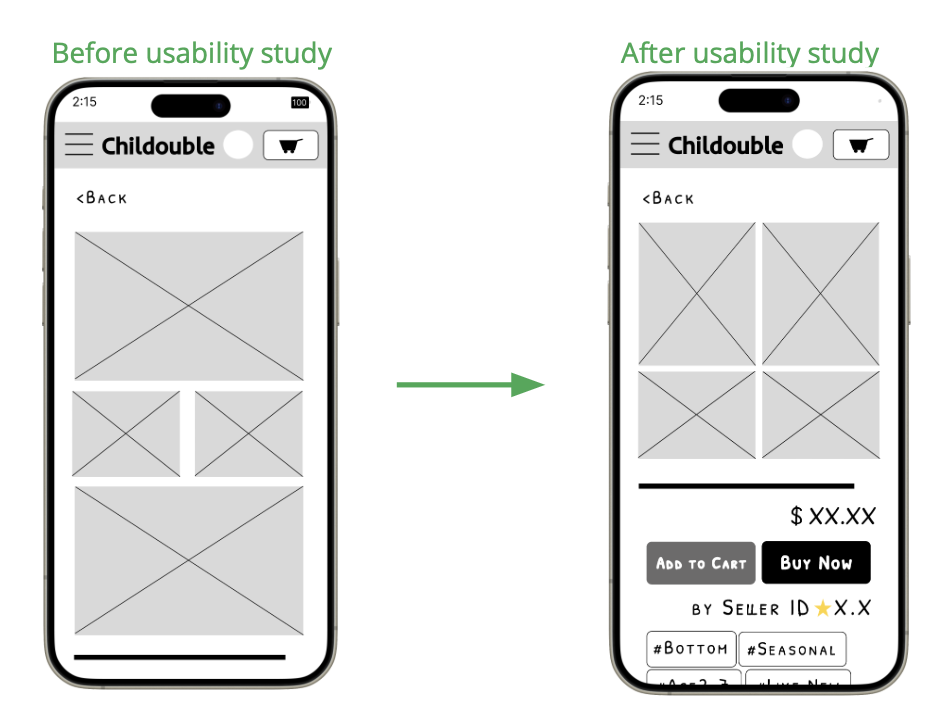Childouble
Where you can pass your stories with children’s outgrown clothings
<Case Study Overview>
As part of the Google Certificate Program project, I conducted a case study focusing on the buying and reselling of children's clothing.
Emphasizing Users
A key aspect of this study was conducting a fictional user interview to uncover common challenges and frustrations related to purchasing and reselling children's clothes.
Decide & Ideate
Using insights from the user interview, I identified pain points and crafted problem statements. This informed the creation of a user journey map and a clear value proposition. I brainstormed solutions and developed wireframes to address these challenges effectively.
Prototype & User Testing
I used Figma to build a prototype based on the proposed solutions. Through iterative user testing, I refined the design based on feedback, ensuring it met user needs.
Impact
Project goal: Facilitate easier access to used cultural garments and accessories for children
Platform purpose: Enable users to share heritage and stories through buying and selling children's clothes
Takeaways
Skills developed: Proficiency in Figma
Design cycle experience- From ideation to prototyping and testing
What I found most rewarding about this project was the process of uncovering insights and understanding user pain points through their honest feedback. This input was crucial in guiding our efforts to address the core problems within the product.
If I relied solely on my initial assumptions – assuming users were primarily motivated by decluttering and financial gain – I would have missed the chance to develop today's product. This product not only helps parents in decluttering and gaining financial value but also serves as a platform for them to explore and share their cultural heritage and stories.
<Details>
Emphasize & Decide
In this context, I conducted a fictional user interview to identify common challenges/frustrations on buying/reselling children’s clothes. Before entering studies, my assumption is that parents to make space from their children’s old clothes and make some financial value out of them. I interviewed 10 fictional individuals from randomly generated individual profiles.
Based on the insights gathered, the following steps were taken:
Identify and define pain points.
Develop personas based on the collected information.
Formulate a clear problem statement.
Construct a user journey map to visualize the entire process.
Create a compelling value proposition based on the identified needs and challenges.
Through this research, I uncovered user needs that surpassed my initial assumptions. This has allowed me to narrow down and focus on specific areas for ideation and wireframing.

![Google UX Design Certificate - Portfolio Project 1 - Case study slide deck [Template]-2.jpg](https://images.squarespace-cdn.com/content/v1/6595b972cb77c624a24f507d/7f37234e-5453-470d-95f7-a1663dec15e9/Google+UX+Design+Certificate+-+Portfolio+Project+1+-+Case+study+slide+deck+%5BTemplate%5D-2.jpg)



Ideate & Prototype
Drawing inspiration from the UX research findings, I initiated the process of ideation and began constructing a wireframe, adhering to the following steps -
Outline user flows
Create Story Boards
Build a Information Architecture (IA)
Create paper wireframes
Create digital wireframes
Connect low-fidelity prototype
![Google UX Design Certificate - User flow [template].jpg](https://images.squarespace-cdn.com/content/v1/6595b972cb77c624a24f507d/8f33a88f-9d43-4557-9fa0-3d4dc128475f/Google+UX+Design+Certificate+-+User+flow+%5Btemplate%5D.jpg)
![Google UX Design Certificate - Portfolio Project 1 - Case study slide deck [Template]-5.jpg](https://images.squarespace-cdn.com/content/v1/6595b972cb77c624a24f507d/55234bdf-ba87-4fd9-a038-45c1022d3142/Google+UX+Design+Certificate+-+Portfolio+Project+1+-+Case+study+slide+deck+%5BTemplate%5D-5.jpg)








User Testing & High-Fidelity Prototype
Through the user testing, I discovered 3 major findings and made improvements.
1. Bundle selling/shopping option
“Usually when I use other similar app, there is ‘bundle’ option. When you clear out over grown clothes, selling one by one is kinda too much work.”
2. Improve Item Information page
Participants experienced confusion when attempting to purchase the item because the 'buy' button was not immediately visible upon opening the item information page. To address this issue, I reorganized the page layout to ensure that the 'buy/add to cart' button is prominently displayed without requiring users to scroll down.
3. Consolidate Sell/Cart/Shop Botton on the top bar
““They gotta do something with this button. It’s keep changing - it was ‘sell’ at one point and now it’s ‘shop’. It’s confusing.”
With the improvements, making mockups with typography, colors, iconography and other design elements.








Impact & Takeaways
The project aims to make it easier for users to find and purchase used cultural garments and accessories for children. Additionally, it provides a platform for users to share their heritage and stories through buying and selling children's clothes.
Through this project, I developed proficiency in Figma and gained experience in conducting the full design cycle, from ideation to prototyping and testing.
What I found most rewarding about this project was the process of uncovering insights and understanding user pain points through their honest feedback. This input was crucial in guiding our efforts to address the core problems within the product.
If I relied solely on my initial assumptions – assuming users were primarily motivated by decluttering and financial gain – I would have missed the chance to develop today's product. This product not only helps parents in decluttering and gaining financial value but also serves as a platform for them to explore and share their cultural heritage and stories.




